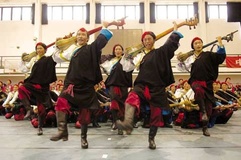Around China: Thangka paintings bring new wealth to Tibetan villages

A Thangka painting[Photo/CNTV]
Luxury SUVs are particularly favored by residents of Tongren County in Qinghai Province, northwest China. Local businessmen use the spacious vehicles to transport their Thangka paintings to buyers.
Four villages in the county -- Senggeshong, Nyanthok, Gomargar and Karsari -- are the birthplace of the Regong branch of Thangka art, one of the most popular. Thangka is a traditional style of Tibetan Buddhist scroll painting.
Toyota Land Cruisers, as well as Audi Q7 and Q5s are common on the street of Tongren, which is administered by Huangnan Tibetan Autonomous Prefecture. Brand new houses and abundant luxury vehicles are the purchases of choice for the nouveau riche in the once quiet Tibetan villages.
"The four villages have some of the country's finest Thangka artists, with some paintings fetching extremely high prices. A single large painting by a thangka master can go for 30 million yuan (4.6 million U.S. dollars) at auction," said Ruan Yuancheng, an official with Regong culture environment protection area, which manages the preservation of thangka art and culture.
In the last few years, thanks to government support and growing interest in the art both home and abroad, Thangka art is turning a pretty penny in these villages.
BOOMING INDUSTRY
The four villages are home to about 20,000 people, 98 percent are someway or another involved in Thangka art. Production value hit 210 million yuan last year.
Thangka is seen as a solution to poverty in many impoverished communities, said Tenzin, a prefecture official. Now many families earn 10,000 yuan annual, and thangka art firms can make 2 million yuan profit every year.
Ma Rui, 28, has spent the last five years learning Thangka. One scroll, which takes her three months to complete, can sell for 20,000 yuan,
"Most of apprentices, like me, come from poor families, and Thangkas give us a career," she said.
Thangka, which has a history of about 1,300 years, was once passed down only in the male lineage of the Buddhists, but over the years, such restrictions have relaxed. According to Huangnan prefecture commerce statistics, Thangka art industry employees have grown by 14 percent every year in the last three years, and output has increased by 20 percent every year.
Listed as a national heritage in 2006, Regong thangka art has received state funding and support ever since. In 2008, Huangnan Prefecture, which administers Tongren, was included in a cultural environment protection program, bringing further funds.
In the four villages, farmers and herdsmen are given free Thangka art instruction, and Thangka masters get subsidies for organizing training. Jampaka, 30, said he receives 20,000 yuan for training 10 apprentices every year.
Shau Tsenten owns a company which produces 20,000 thangkas every year. His works are favored by collectors in Beijing, Shenzhen and Guangzhou.
Regong thangkas are also now sold to countries such as France, the United States and Australia.
SHODDY QUALITY
Many artists have begun to worry about the downside of the art form's popularity.
"We have seen dangerous signs in the last two years. Some painters use water color in place of natural mineral pigments, such a practice shall not be tolerated," said Ruan Yuancheng.
Local craftsmen and painters plan to form an association to better enforce self-discipline and appraise the quality of paintings.
Those who produce substandard paintings will be excluded from the association and not allowed to attend cultural gatherings, Ruan said.
Local artists hope they can maintain the popularity of their paintings and use the Internet to sell their paintings.
"We have been using our personal connections to sell Thangkas to buyers in European countries. We hope that more government-level exchanges will help us exploit the foreign market," said Shau Tsenten.
Editor: Ellen Liu
Your Comment
Name E-mailRelated News
-
;
-
-

-
Tibet’s 10 intangible cultural heritage inheritors' skills record
Recently, the skills of ten national intangible cultural heritage representative successors were recorded.
-
-
-

-
Winners of the "Charming Tibet" photography contest announced
Photographers have responded enthusiastically to the "Charming Tibet" photography contest.
-











